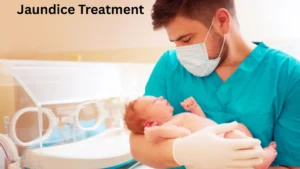Jaundice Treatment: Jaundice, a condition marked by yellowing of the skin and eyes, remains a significant health concern globally. It’s not a disease itself but a symptom of underlying conditions, most commonly involving the liver, gallbladder, or pancreas. This comprehensive 2025 guide explores everything you need to know about jaundice: from causes and symptoms to treatment, costs in India, and expert recommendations.
What Is Jaundice?
Jaundice, medically known as hyperbilirubinemia, is a condition where there is excess bilirubin in the blood. Bilirubin is a yellow pigment formed by the breakdown of red blood cells. Normally, the liver filters this pigment and excretes it in bile. However, if this process is disrupted, bilirubin builds up in the body, causing yellowing of the skin, eyes (sclera), and mucous membranes.
Types of Jaundice
Understanding the type of jaundice is essential for accurate treatment:
- Pre-hepatic Jaundice:
- Caused by excessive red blood cell breakdown.
- Common in conditions like malaria or hemolytic anemia.
- Hepatic Jaundice:
- Caused by liver dysfunction, such as hepatitis, cirrhosis, or alcohol-induced liver disease.
- Post-hepatic (Obstructive) Jaundice:
- Caused by blockages in bile ducts due to gallstones, tumors, or strictures.
Causes of Jaundice
- Viral Hepatitis (A, B, C, E)
- Alcoholic Liver Disease
- Gallstones or Bile Duct Obstruction
- Hemolytic Anemia
- Autoimmune Hepatitis
- Liver Cancer or Pancreatic Tumor
- Congenital liver disorders in newborns
Jaundice in Newborns vs Adults
Neonatal Jaundice:
- Common in newborns within the first week.
- Usually due to immature liver function.
- Treated with phototherapy or in rare cases, exchange transfusion.
Adult Jaundice:
- Usually indicates liver disease or bile duct obstruction.
- Requires in-depth diagnosis and targeted treatment.
Symptoms of Jaundice
- Yellowing of skin and eyes
- Dark-colored urine
- Pale-colored stools
- Fatigue and weakness
- Fever or chills (if caused by infection)
- Nausea or vomiting
- Abdominal pain (especially in the upper right quadrant)
- Itchy skin
Read more: Gastroesophageal reflux disease treatments Guide 2025: Symptoms, Options, Costs & Innovations
Diagnosis of Jaundice
To determine the cause and severity of jaundice, doctors recommend:
- Liver Function Tests (LFTs)
- Bilirubin Blood Tests
- Ultrasound/CT Scan of the abdomen
- Hepatitis Panel
- Liver Biopsy (in chronic or unclear cases)
Treatment of Jaundice in 2025
Treatment depends on the underlying cause, and options include:
1. Phototherapy (for newborns)
- Blue light breaks down excess bilirubin through the skin.
2. Medications
- Antibiotics for infections like hepatitis A or typhoid.
- Antivirals for hepatitis B and C.
- Steroids or immunosuppressants for autoimmune hepatitis.
3. Surgical or Endoscopic Procedures
- To remove gallstones or tumors blocking the bile ducts.
- ERCP (Endoscopic Retrograde Cholangiopancreatography) is commonly used.
4. Blood Transfusions
- Recommended in hemolytic jaundice or for neonates with high bilirubin.
5. Liver Transplant
- In cases of end-stage liver failure, transplant may be life-saving.
Lifestyle and Dietary Changes
Managing jaundice involves supportive care through:
- Hydration: Drink 2.5–3 liters of water daily.
- Balanced Diet: Include liver-friendly foods like leafy greens, turmeric, and fresh fruits. Avoid fatty, sugary, and processed foods.
- No Alcohol: Alcohol can worsen liver damage.
- Adequate Rest: Supports natural healing processes.
Jaundice Treatment Cost in India (2025)
| Treatment Type | Estimated Cost (INR) |
|---|---|
| Consultation & Diagnosis | ₹500 – ₹2,000 |
| Phototherapy (Newborn) | ₹2,000 – ₹10,000 per session |
| Medications (Hepatitis etc) | ₹1,000 – ₹15,000/month |
| ERCP Procedure | ₹30,000 – ₹70,000 |
| Blood Transfusion | ₹3,000 – ₹10,000 |
| Liver Transplant | ₹18,00,000 – ₹30,00,000 |
Note: Costs may vary depending on city, hospital type, and severity.
Real Case Example: Jaundice-Induced Liver Failure
In May 2025, two teenage girls in Kerala succumbed to acute hepatitis A-induced jaundice despite advanced treatment. They were initially managed with plasma exchange therapy and ventilator support. Doctors recommended liver transplantation, but rapid deterioration led to fatal outcomes. This tragic case highlights the importance of early intervention and proper diagnosis.
Preventing Jaundice
- Get vaccinated against hepatitis A and B.
- Practice safe hygiene and food habits to avoid infections.
- Limit alcohol and avoid self-medication.
- Avoid herbal remedies without doctor supervision.
- Control weight and manage cholesterol to prevent fatty liver.
Risks of Untreated Jaundice
- Liver failure
- Brain damage (especially in infants – kernicterus)
- Chronic hepatitis
- Gallbladder cancer
- Death in severe or neglected cases
When to See a Doctor
Seek immediate medical attention if you notice:
- Yellowing of eyes or skin
- Severe abdominal pain
- Blood in stool or vomiting
- Fever, fatigue, or confusion
- Rapid weight loss
FAQs on Jaundice Treatment
Q1. Can jaundice be cured completely?
Yes, if treated early and the underlying cause is resolved.
Q2. Is jaundice contagious?
Only jaundice caused by viral hepatitis A or B can be contagious.
Q3. What is the fastest way to recover from jaundice?
Follow medical advice, stay hydrated, eat a clean diet, and avoid liver-stressing substances like alcohol.
Q4. How long does it take to recover from jaundice?
Mild cases resolve in 1–2 weeks; chronic conditions may take months.
Q5. Is jaundice dangerous during pregnancy?
Yes. It can indicate liver complications and must be closely monitored.
Final Thoughts
Jaundice is not just a yellowing of the skin—it is a clear indicator that something is wrong inside your body, particularly with your liver or bile ducts. While modern treatments and early diagnosis offer hope, prevention and lifestyle management are crucial. In India, with advanced diagnostic tools and affordable healthcare, most jaundice cases can be successfully treated.
If you or someone you know shows symptoms of jaundice, do not ignore them. Consult a healthcare provider immediately and ensure proper testing and treatment.





